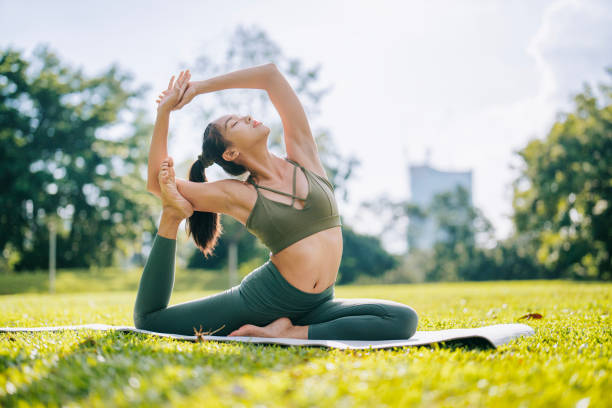admin
September 27, 2024
Impact of Ashtanga Yoga on Mental Health & Well-being

Yoga has become the most popular holistic practice of late, and it has been shown to help individuals improve their mental health and well-being more profoundly. Among all the yoga forms, Ashtanga Yoga is unique about its style of carefully sequenced postures and its effects on the body as well as in the mind. This article explains how this type of yoga would affect mental health: benefits, the pattern of practice, and how it could be applied to daily life.
It is a dynamic practice that, through its methodical sequence of postures along with synchronized breathing, offers various mental health benefits like stress reduction, anxiety relief, and improved emotional regulation. As we explore these, we will also highlight the specific benefits of Ashtanga Yoga, the steps, and practical advice on incorporating it into life.
What is Ashtanga Yoga?
Ashtanga Yoga has the foundation firmly rooted in the philosophy of ancient India. The practice finds its roots through the Yoga Sutras of Patanjali, which basically describe an eight-limbed path to spiritual enlightenment. However, the modern form of this type of yoga was popularized by Sri K. Pattabhi Jois in the 20th century. Jois’s system is called “Ashtanga Vinyasa Yoga,” where a person incorporates physical postures (asanas) together with vinyasa of breath control and focused gaze with drishti and internal body locks with bandhas. This system allows for a strong and structured approach, which makes it unique from all the other yoga styles.
Practice Structure
The structure of Ashtanga Yoga defines its specific arrangement of postures, which are conducted in a particular pattern. Practice consists of dynamic postures as every posture flows into the next with breath. The two main aspects include:
Vinyasa: Breath-synchronized movement that leads to a flowing series of postures. There is a flow connecting the postures, which allows for smooth transitions in between and rhythm of the practice.
Drishti: Focused gaze or eye position which helps one maintain focus and prevent mental clouding. The correct form of each posture has a particular drishti for one to hold while maintaining awareness in the present.
Bandhas: Inner locks inside the body that activate the core and thereby giving the proper realignment of the body. Practicing bandhas consolidates the body and controls the energy flow.
Daily Routine
A typical Ashtanga Yoga class involves a series of postures practiced in a specific order and lasts anywhere from 60 to 90 minutes. It is repetition and gradual progression that can build strength, flexibility, as well as the mental endurance that are aspects of the practice of Ashtanga Yoga. And you embark on a transformative journey with our Ashtanga Yoga Teacher Training Course, designed to deepen your practice and empower you as a skilled instructor.
Mental Health Benefits
Stress Reduction
Probably, one of the most essential benefits is its ability to reduce the physical and mental stress level of the body. This practice stresses breath-centered movement and continuous flow, thus reducing levels of cortisol hormone, which is associated with stress. The rhythmic breathing and flowing movement assist to enter into deep relaxation and mental quieting.
Stress Management
It can be highly useful in the management of anxiety. The controlled breathing and mindful movement focus helps to regulate the autonomic nervous system, reducing symptoms of anxiety and creating an atmosphere of calm. Mental discipline that is an intrinsic part of the Ashtanga Yoga asanas supports emotional stability and enables better handling of anxiety situations. Ashtanga Yoga can become a highly effective tool for individuals suffering from anxiety. Regular practice can be quite restorative for mood and may help offset emotional fluctuation. The physical activity triggers endorphins, which are natural mood elevators. Secondly, the task-structured nature of this yoga makes it useful for people suffering from depression: to have a sense of accomplishment and purpose. The discipline involved ensures that one can generally achieve emotional health.
Increased Concentration and Clearness
The required intensity enhances cognitive development. Clarity and attention develop in the practice through drishti (gaze) and the harmony between breath and movement. Ashtanga Yoga routine engagement benefits practitioners in daily life by developing focus and cognitive function. Improved focus and clarity are the essential benefits that make the practice so valuable.
Emotional Regulation
It helps in regulating emotions through the building up of self-awareness and mindfulness. Individuals will learn not to judge their feelings; they learn to understand their emotional responses and not act against them. In doing so, they will be able to develop an improved emotional response in better ways. The potential to apply improved emotional regulation stands out as a massive benefit of Ashtanga Yoga training. It promotes balanced emotional response. This is because the more one balances their emotional response, the more emotionally resilient and stable they become.
Physical Benefits and Their Impact on Mental Well-being

Greater Muscle Strength and Flexibility
Physically, it lends itself directly to emotional advantages. As one increases muscular power and flexibility with Ashtanga Yoga, for example, an increased awareness of one's body provides a sense of security and empowerment. Performing complex postures and control over movements performed by the body increases self-esteem and a positive self-concept. Other physical improvements contribute to well-being and sound mental health.
Awareness of Body Endowment
An overall enhancement of proprioception-that is, a greater sense of the orientation of body parts-would be the by-product of practices and you can also learn about the importance Ashtanga Yoga 10 points. As individuals form deeper connections with their bodies, they gain more profound self-acceptance and clarity of mind. The inner sense of awareness of one's body inspires the development of better self-care and generally balanced health behaviors. Body awareness increases with this practice, thus energizing the mind/body interaction.
Improved Sleep
Another critical aspect is sleep quality improvement. Because of the physical force involved and through relaxation techniques, the pattern of sleeping improves, and thus, quality sleep is ensured. Better sleep also ensures good mental health since it provides better moods, cognitive activities, and total emotional control. In that case, quality sleep is one benefit provided by Ashtanga Yoga for mental well-being.
Scientific Evidence for Benefits
Research Studies
Many have dealt with the psychological benefits that brings to the participants. Evidence also reveals that participants of this yoga significantly experience a decrease in symptoms of stress, anxiety, and depression. Some articles cited by journals further reveal aspects and improvements gained in the participants after engaging in Ashtanga Yoga steps, such as improvement in conditions of mood and a decrease in the rate of anxiety or concern. Thus, these findings support the effectiveness in terms of psychological healing.
Opinions of the Experts
Experts in psychology and yoga always tend to emphasize the merits on mental health. Psychologists generally recommend poses as adjunct therapy to keep stress and anxiety under control. Of late, yoga experts have claimed that it can even build mental discipline and emotional equilibrium. Lessons from experts bring out useful aspects that improve mental health.
Anecdotal Evidence
Personal accounts and anecdotal studies also contribute to understanding the wide-ranging advantages of Ashtanga Yoga. Generally, any individual practicing on a regular basis would comment that their mental condition and overall well-being considerably improves. These tales represent how effective it can be in fostering friendly or positive mental health settings as well as uplifting well-being.
How to live Ashtanga Yoga
Practical Tips
For anyone interested in trying out the advantages of Ashtanga Yoga, a structured approach would always be the best place to start. Watch for local classes or instructors in your area by searching for "Ashtanga Yoga near me". Practicing at home is also a must, and there are now several online resources one can use to help navigate Ashtanga Yoga. The further practice builds up on the overall advantages.
Adjusting the Practice
It can be adjusted according to an individual's needs and limitations. Beginners should begin with fundamental postures and progressively escalate according to growth in strength and flexibility. This should be done while tuning into the body, adjusting the postures if need be to ensure safety and effectiveness of the practice. In this manner, by adjusting Ashtanga Yoga to suit an individual's needs, its benefits are optimally gained, and the practice is more readily accessible.
Implementing Ashtanga Yoga poses into the daily lifestyle is contingent upon the establishment of concrete goals and practices. To start with, there has to be an incentive to pursue practicing Ashtanga Yoga, which may be motivated by finding a local community or by having a practice buddy to share the enthusiasm with. While monitoring progress and celebrating every milestone achieved can help sustain efforts and interest in practicing ashtanga yoga benefits weight loss, setting an inspiring atmosphere is what aims at building the general ambiance of the exercises.
Conclusion
Ashtanga Yoga before and after merges respiration control, movement, and internal reflection to assist the person to adopt a scientifically-controlled approach toward mental health. It is more than just a body fitness program as it assists to reduce stress, anxiety level, and improves mood along with emotional balance. As a whole, it can play a very productive role in healing and balancing the mentality of a human being for his realization of maximum success in his life.
If you are interested to learn about it and how it will better your mental condition, then you may want to take a class, try some at home practices, or learn more about this amazing practice. Join the journey of Ashtanga Yoga and discover how it can work to improve the quality of your life.
Frequently Asked Questions
The eight major limbs are: Yama (ethical standards), Niyama (self-discipline), Asana (physical postures), Pranayama (breath control), Pratyahara (withdrawal of senses), Dharana (concentration), Dhyana (meditation), and Samadhi (absorption or enlightenment).
The Ashtanga Yoga movement is the practice performed in a very specific sequence of postures flowing from one posture into the other with synchronized movement and breathing. This technique ensures that proper integration of breath, movement, and mental focus brings benefits to both body and mind.
The steps are the execution of postures in a certain arrangement with simultaneous breathing and movement (vinyasa) along with some focused gaze (drishti) and internal body locks or contraction bands (bandhas). These have to be done as part of an entire Ashtanga Yoga program.
This program differs from others because of the strict sequence of postures and breathing coordination. Other schools may focus more on the flexibility or on meditation, but the emphasis here is on an active flowing practice which combines bodily and mental training.
This can be done through online searching for yoga centers or instructors practicing Ashtanga in your locality. Many Yoga Centers and fitness studios publish information on Ashtanga Yoga classes and schedules.


